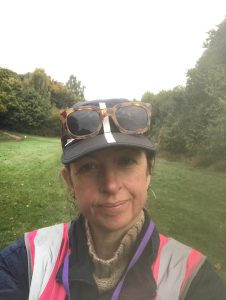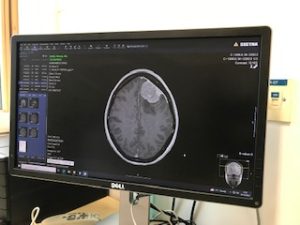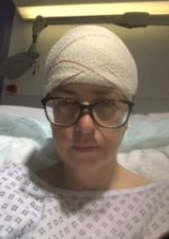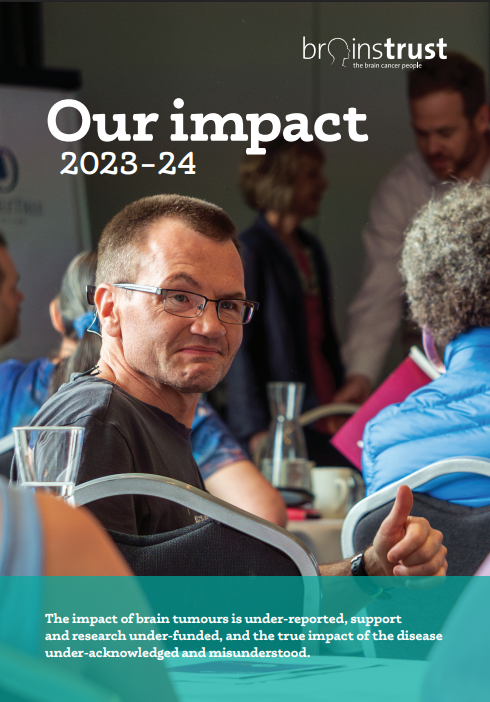 Nikki’s story
Nikki’s story
In early March 2022, I started to get very bad headaches. They were not like anything I’d experienced before, more like attacks really: very brief – just a minute or two – but intense and disabling. They were always focused in the same place: the left, upper part of my head. It was as if they were trying to tell me something.
I went to my GP, who did some tests: could I stand on one leg? lift both arms? He couldn’t immediately identify a problem. The headaches got worse and in the next few weeks I went to an osteopath, an optician, a pharmacist and A&E. Eventually I went back to my GP and, at the end of April, he sent me for an MRI.
I remember the scan, the claustrophobia and the noise of it. I remember the tiny battered mobile unit in the hospital car park where it took place. I remember the radiographer telling me afterwards that I should not go home. I remember sitting on an uncomfortable trolley behind a blue curtain in A&E for hours. I remember the hot, strong cup of tea someone gave me. I remember a senior nurse, sitting on the end of the bed and holding my gaze as she told me there was a lesion on my brain. What I don’t remember is feeling anything at all. 
This numbness persisted for the next few weeks, through more scans and phonecalls and appointments and a haze of steroids, as I grew weaker and more debilitated – almost as though the diagnosis had given me permission to let everything go and stop trying. My work, as a freelance writer, ground to a halt.
A letter arrived telling me I’d been referred to a neurosurgeon at a hospital two hours away from my home. He wanted to operate soon. He thought the ‘lesion’ was a large meningioma that had been growing for at least 10 years, maybe 15 or even 20. I thought of all that time it had been there, slowly invading my brainspace. All the things I had done and places I’d been to, unaware of its presence. I wondered how it began? What might possibly have caused it? There are no answers.
I lost a lot of time when they operated. I recall being driven to a hotel the night before the procedure, but nothing else for three or four days. Apparently, though the initial operation was a success and they removed all the tumour, my brain began to swell immediately afterwards – something they didn’t expect. I had to be transported to a different hospital, in a special for-God’s-sake-don’t-move-her-head wheelchair, for an emergency decompressive craniectomy – the permanent removal of the bone flap to relieve pressure on the brain. I think I was very poorly indeed – though it depends who I ask. My surgeon says ‘you were a bit drowsy’, my mum says ‘I thought I was going to lose you’.
The Glasgow Coma Scale, a measure used by doctors to assess a patient’s level of consciousness, goes from 15 down to three – 15 meaning you’re bright-eyed and bushy-tailed, and three meaning you’re in a deep coma. During those days, my GCS dropped to five. So things could have been worse, but maybe not much.
I finally came round after this second operation, a large piece missing from my skull, my mum and brother sitting by my bed. My memories of the next few days are vague: a woman next to me endlessly repeating the same nonsensical words, a nurse giving me a bed bath at what seemed like four in the morning, a visit from a physio, some tentative walking, a wobbly attempt at stairs. My right side was weak, but functioning, my speech was muddled, but made some kind of sense, my memory was in disarray. They sent me home after about five days. It seemed too soon, but I guess no one really gets better while they are in hospital.
The NHS is chaotic and stretched to its limits, but at the same time it is brilliant. My consultant was highly skilled and made excellent decisions that probably saved my life. I encountered incredible compassion and kindness, from cleaners, porters, health care assistants, nurses. Most doctors. But the NHS doesn’t have the resources for much aftercare or ongoing support. Once I was out of hospital, I felt I was on my own. And sometimes, the isolation and loneliness have been hard to bear.
We usually think about things in a linear way: we say we’re making progress, moving on, taking steps, even going backwards. But my recovery has not been like that. It’s been a ramshackle collection of events that I don’t seem to have much control over.
I’m a single parent and my kids had to go and live with their Dad. I’ve had an absolutely terrifying seizure. I’ve lost my driving licence three times. I’ve had three more surgeries on my skull – one to put a titanium plate in, one to patch up the failing wound, one to take the plate out altogether. (I’m waiting for another op now, to insert a second plate. Fingers crossed.) I worry constantly about money. I have side-effects from my anti-seizure medication – not least mind-warping anxiety.
But I am alive, I can walk and talk and even do a bit of work. I am one of the lucky ones. I find humour in bleak places: getting memes from a friend in the midst of awful antibiotic-induced nausea, or taking selfies of the dressing on my scalp on which someone had helpfully written ‘no bone flap’.

I first contacted brainstrust about 18 months after my initial operation. I was desperately low, and I resolved to just ask for help in as many different places as I could. Brainstrust was one of those places and I wish with all my heart someone had told me about them before, that I didn’t have to go through those awful months unsupported. Within days, I had begun coaching sessions with Mariel. Within weeks I had a peer supporter, Imelda – the first person I’d ever spoken to who also had a brain tumour. Within months, I was volunteering to be a peer supporter too. There were so many resources: Facebook groups, Zoom calls, in-person meet-ups. Brainstrust gave me a community, people who know what it’s like to have something go very wrong inside your skull.
I have absolutely no idea what my future holds. I still have terrible days. It’s taken me a week to write this story, when before it would have taken a couple of hours. But I have been able to get perspective and to develop coping strategies. I break tasks down into little chunks, I make lists everywhere, I take one hour at a time. And when things are really bad, I try to find something that makes me laugh. Because without humour, we’re lost, aren’t we?








